7 Best Lead Generation Software of 2024 (to Get More Leads)

Want to jump straight to my top picks? The best lead generation software is Unbounce and HubSpot.
Many marketers are currently struggling with lead generation. They produce content that engages their clients but they can’t seem to convert their lead into paying customers.
It’s hard to get the right information from visitors and follow up in a timely fashion to convert them into paying customers. You can’t afford to lose any potential clients, but you’re tired of spending money on tools that don’t work well together.
The great news is that B2B companies that have their lead generation process down pat experience more than 130% increase in their revenue – compared to other companies.
The truth is that you can have the best landing page builders in the world to collect leads, but if you don’t properly nurture them after, all your efforts will be in vain.
In this post, I’m going to walk you through 7 of the best options for lead generation software, explain what they do, and help you choose the best one for your business.
Disclaimer: This article contains affiliate links that I may receive a small commission for at no cost to you if you purchase a plan. However, these are the tools I have vetted and fully recommend when it comes to lead gen. You can read my full affiliate disclosure in my privacy policy.
What is the Best Lead Generation Software?
Here are my top picks for the best lead generation software tools.
1. Unbounce.
Best for creating personalized landing pages ($80 per month).
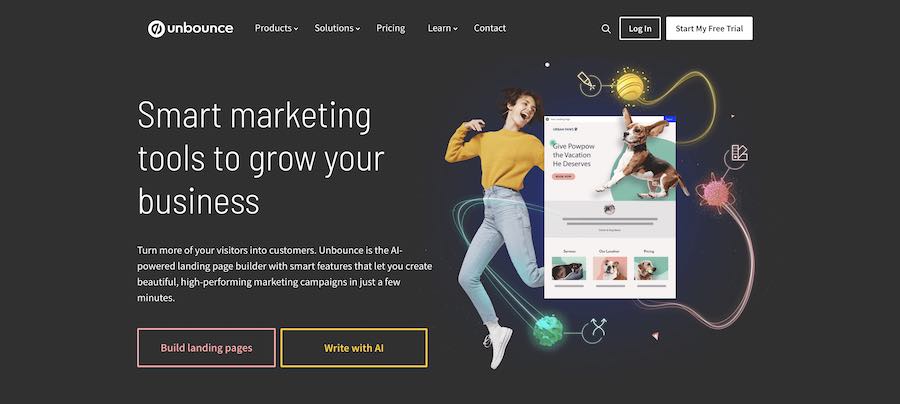
Unbounce is a landing page builder and platform that helps you generate more leads, sales, and customers.
It’s suitable for various industries like SaaS, agencies, and e-commerce. Plus, they cater to all PPC, social ads, and email marketing campaigns.
Unbounce helps you build, customize and optimize landing pages to make them conversion-friendly and capture leads. You can either create your sales page from scratch or customize pre-built templates using its drag-and-drop builder.
Unbounce provides elements like 100+ customizable templates, customizable grids, Google Fonts, 85000+ images, and 240+ themes to create landing pages. You can further add opt-in forms, custom messages, videos, parallax scrolling, and light-boxes.
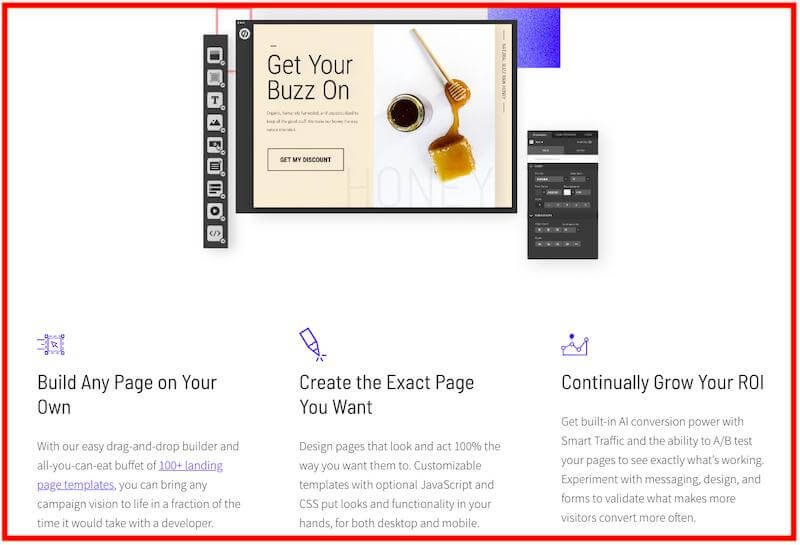
Besides landing pages, you can also create “Popups” and “Sticky Bars” to prompt website visitors to take a particular action. It lets you embed pop-up offers and forms anywhere, on any page, and integrate customer search terms to boost relevance.
You can even embed sticky bars and popups based on triggered actions, location, location, referral URL, and cookies. Plus, it allows you to set and schedule offer frequency.
Other key features include:
- AMP (Accelerated Mobile Pages) landing pages.
- Add and manage Custom pages with Script Manager.
- Duplicate landing pages and copy elements across them.
- Create and control accelerated mobile versions of all pages.
- Publish landing pages to custom URL, domain, or WordPress.
- Add custom JavaScript, CSS, and HTML to any webpage.
- Create gated content to capture and nurture leads.
- Use Smart Traffic tools to segregate customers based on their interests.
- Single sign-on, log audits, and multi-user access permissions for privacy control.
- Forecast customer interactions through A/B testing and real-time reports.
Additionally, Unbounce allows integrations with marketing automation or CRM tools like Salesforce, Mailchimp, HubSpot, etc. Its Script Manager also enables integration with Google Analytics and Facebook Pixels.
Besides, you can connect with Zapier and Webhooks to enable thousands of other integrations as well. Unbounce also provides security features like two-factor authentication, SSL encryptions, and compliance with GDPR, CASL, and PCI-DSS.
Pricing:
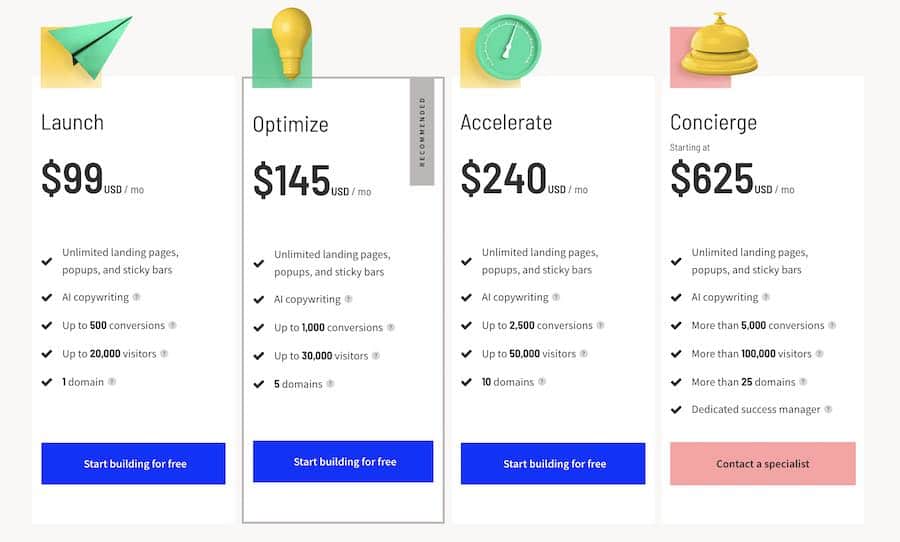
Unbounce offers four pricing plans, including:
- Launch: $99 per month (up to 500 conversions)
- Optimize: $145 per month (up to 1000 conversions)
- Accelerate: $240 per month (up to 2000 conversions)
- Scale: $625 per month (up to 3000 conversions)
The plans provide unlimited landing pages, pop-ups and sticky bars, and a 14-day free trial.
2. HubSpot.
Best overall lead generation software ($50 per month).
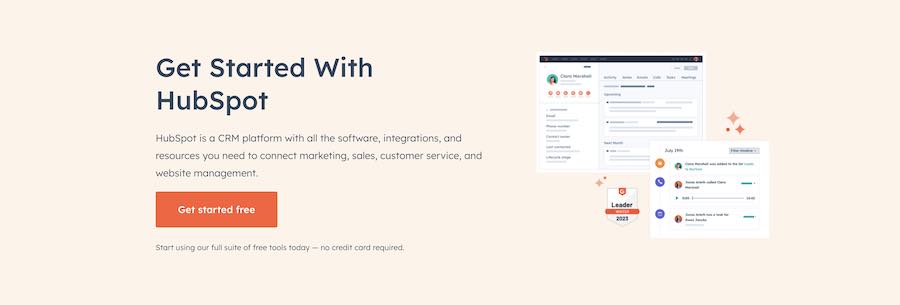
HubSpot is a B2C and B2B lead generation software that offers solutions for inbound marketing, sales, CRM, and customer support.
You can use a single dashboard to manage business analytics, CRM, social media marketing, generate leads, marketing automation, and more.
HubSpot helps you with blogging, social media ads, creating landing pages, marketing automation, a sales pipeline and more to attract and convert leads. It also provides revenue attribution reports to track ROI (return on investment) and other essential metrics.
Ad tracking and social media management are also helpful to generate and nurture leads. HubSpot helps you manage and track Facebook, Instagram, LinkedIn, and Google ads from a single dashboard.
Some of HubSpot’s key lead generation features include:
- Monitor and prioritize social media conversations.
- Embed video content on social media.
- Use the live chat to connect with visitors in real-time.
- Email automation and tracking tool.
- Automatically assign potential leads to the right sales representative.
- Create automated follow-up tasks.
- Create webinars to generate leads.
- Contact and lead management.
- Meeting scheduling.
- Gmail and Outlook integration.
- Turn repetitive sales emails into templates.
HubSpot also helps you build mobile-friendly forms, pop-ups, banners, and slide-ins to turn your website visitors into leads. You can even embed all these elements to any web page on your site.
HubSpot’s CRM services include email and meeting scheduling, lead predictions, AI-based sales automation, etc. The dashboard also lets you monitor the number of sales calls, emails, meetings, and tasks each sales rep completes.
HubSpot functions as a full fledge sales management software in addition to everything else it does for lead generation.
The software also offers customer support services. It helps you expand the customer base through ticket creation bots, goal-setting, and more.
The latest addition, CMS Hub, helps you build impactful websites. You can also interact with customers and register their feedback through live chat, generate SEO-friendly content, monitor potential threats, etc.
Pricing
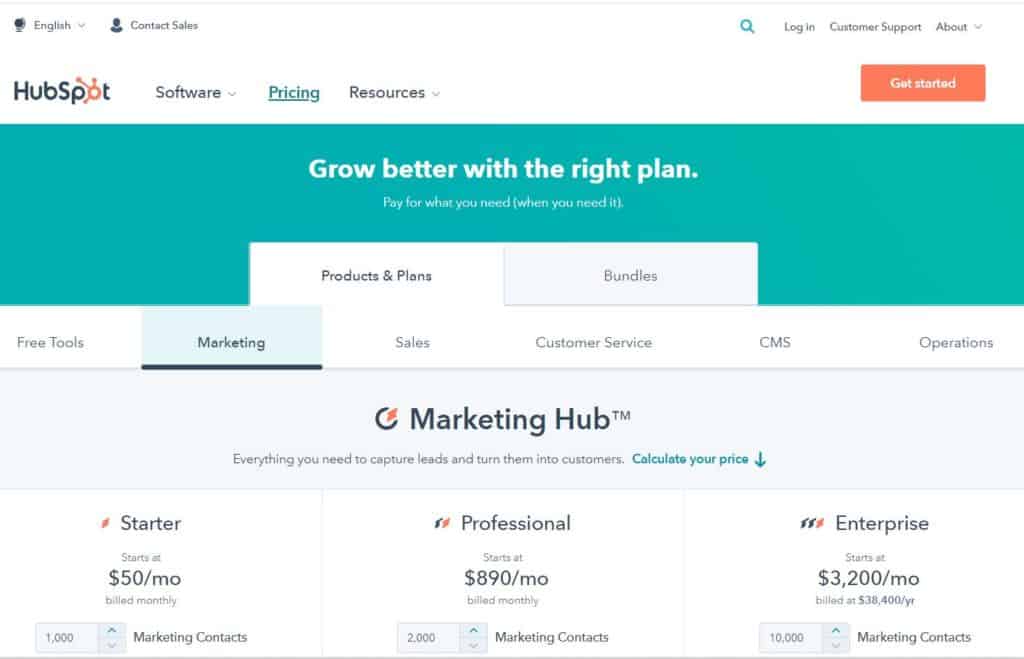
HubSpot Marketing Hub comes with four pricing plans:
- Free: $0 a month.
- Starter: $50 per month
- Professional: $890 per month
- Enterprise: $3200 per month
The free marketing plan includes email marketing, contact management, promotion on Facebook, Instagram, and other social networks, business analytics, etc.
On the other hand, all of the paid plans include SEO tools, marketing tools, the scope of video hosting and management, social media and blog creating tools, and more. HubSpot also offers a free trial and a completely free CRM tool.
3. OptinMonster.
Best for A/B testing sales offers and landing pages ($9 per month).
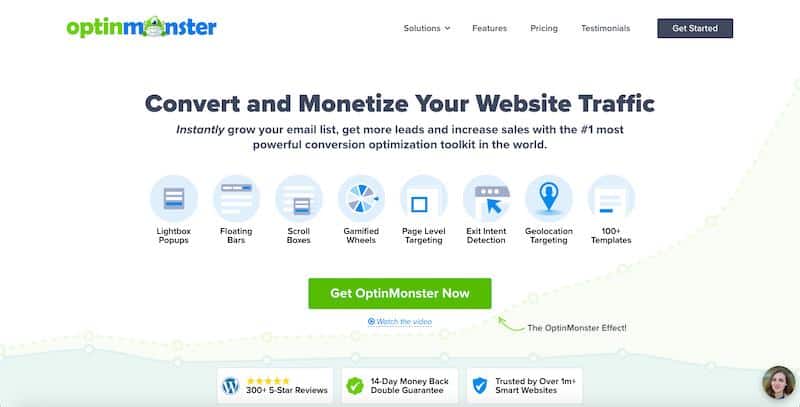
OptinMonster is an email opt-in tool that helps you convert abandoning visitors into customers and subscribers.
It offers over 100 templates to generate leads, gain more email subscribers, reduce cart abandonment rate, and more.
It offers various options like lightbox popups, floating bars, gamified wheels, and more to interact with visitors and generate leads. Other services include scroll boxes, page-level targeting, exit-intent detection, and geolocation targeting.
You also get the option to either choose a pre-built template or create a new page from scratch. It allows you to create sales offers without any coding know-how using a drag-and-drop builder.
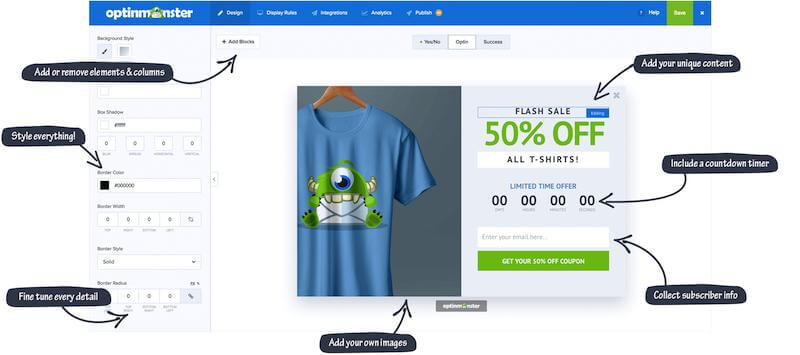
Another key feature of OptinMonster is its conversion strategies based on behavioral automation. This helps you track customer behavior and promote your offer to the right customers at the correct time.
OptinMonster further provides access to real-time stats to help you plan the future course of action. You can also split test different layouts, headlines, and content in real-time to check what performs the best. This will help you convert more leads into permanent subscribers.
OptinMonster’s most prominent features include:
- Pre-designed and customizable lead capture forms.
- Detailed analytics and insights.
- Real-time behavior automation.
- 26+ animation and sound effects.
- Times display control.
- HTML elements and JavaScript variables.
- OnSite Retargeting and personalization.
- Send welcome emails to grab the attention of new leads.
- In-built conversion optimization analytics.
- Segment your email list and group subscribers to send targeted offers.
- Send geo-targeted offers based on local climate and culture.
OptinMonster also offers Advanced Traffic Redirection that lets you direct website traffic to important pages on your website automatically. It will also help you add a CTA button, customize the sales flow, and track customer engagement.
There’s also a unique feature called the InactivitySensor. The InactivitySensor tool detects visitors’ behavior and notifies when your target audiences are inactive. You can then quickly display and re-engage them with an attractive.
It also allows you to integrate with multiple business tools like Salesforce, Mailchimp, WordPress, Zapier, Intercom, Kajabi, Shopify, Weebly, etc.
Pricing
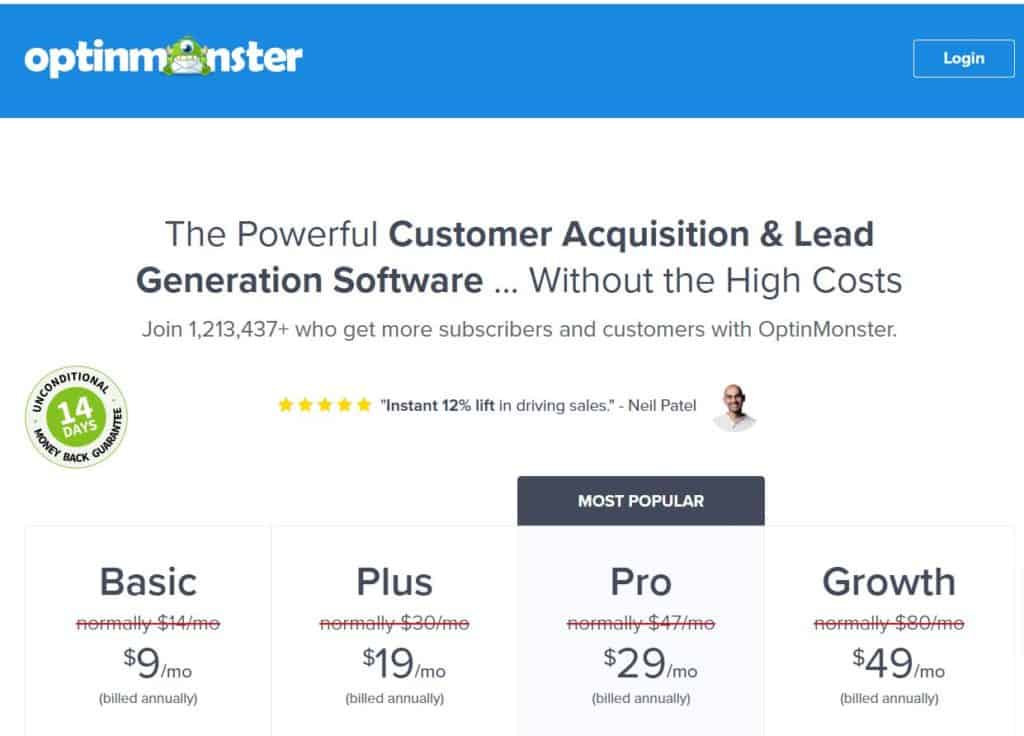
OptinMonster offers four pricing plans, including:
- Basic: $9 per month
- Plus: $19 per month
- Pro: $29 per month
- Growth: $49 per month
All of the plans offer features like page-level targeting, list segmentation, subscriber recognition, unlimited campaigns, third-party integrations, and more. OptinMonster also offers a 14-day money-back guarantee with all of its plans.
4. Intercom.
Best for engaging website visitors in real-time ($59 per month).
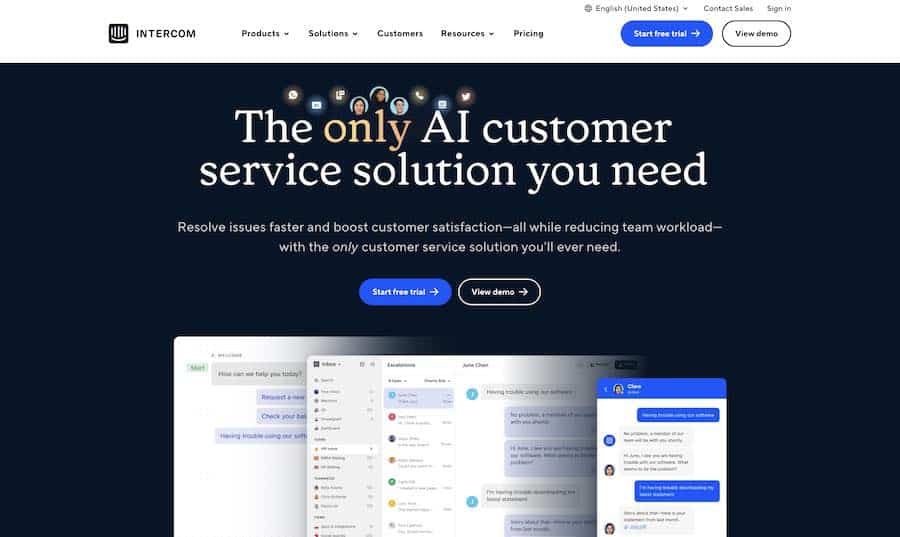
Intercom is a lead generation platform that helps you acquire customers with chatbots and through real-time conversations.
It helps you engage your visitors and automate and scale conversation with each customer without bothering your team.
Chatbots and other interactive tools help you target website visitors and automatically greet them with personalized messages. These automated bots will chat, direct conversation, acquire information like phone numbers, and schedule meetings for you.
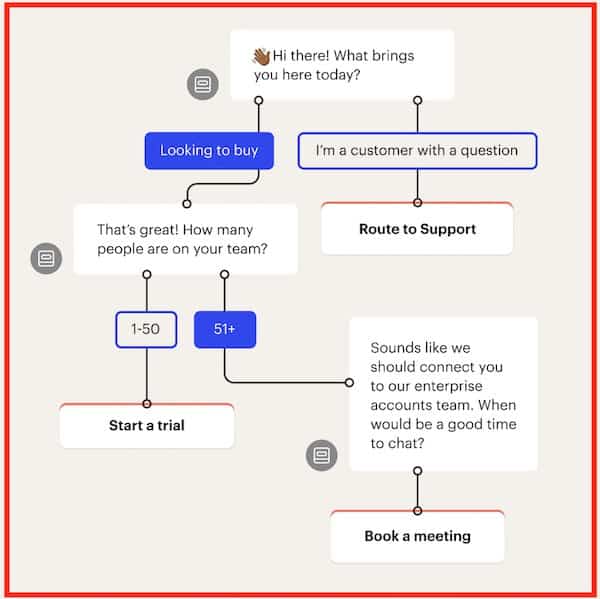
The software also offers management tools to customize and organize your team’s workflow. It directs conversations based on the potential customer’s actions and their company’s size and requirements and further assigns the lead to an appropriate sales rep.
Intercom also functions as a customer data platform that helps you segment your messages based on all of the data. After that, it connects target accounts to account owners with real-time Account-Based Marketing (ABM).
Here’s a quick overview of Intercome’s most prominent features:
- Conduct real-time chat and follow-ups.
- Access to real-time business analytics.
- Customer self-service options.
- Prioritize high-quality leads and loyal customers.
- Unify customer data from entire tech stacks.
- Use apps within chatbots to automate workflows.
- Track and trigger business by monitoring customer behavior.
- Re-engage and target customers with targeted messages.
- Create a collaborative inbox to provide fast and personalized customer support.
- Automated email campaigns to acquire leads and retain existing customers.
- It automates processes like routing, assignments, and SLAs (Service-level agreement).
Integration with tools like Clearbit Reveal and Marketo also helps you identify, acquire, and nurture leads directly from Intercom’s dashboard.
It also integrates with other third-party marketing and business tools like Salesforce, Stripe, Shopify, and more. Intercom also uses APIs to integrate with other marketing apps, such as Google Meet, Facebook, Google Analytics, etc.
Pricing:
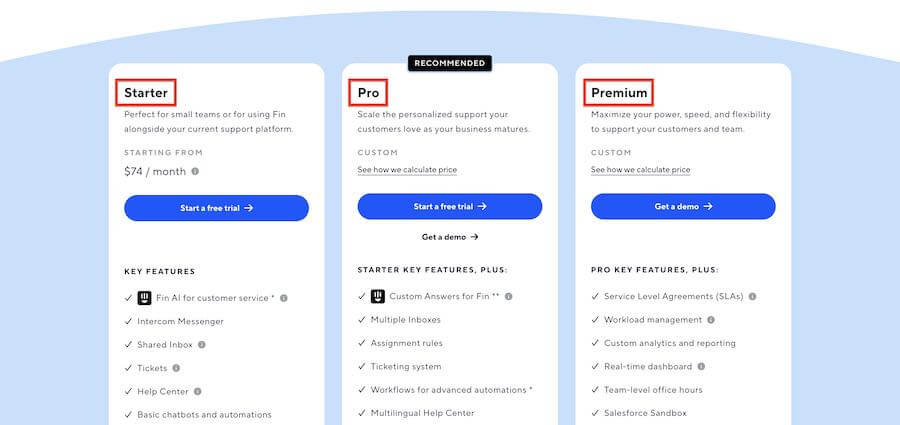
Intercom offers two different types of plans for “ Most Businesses” and “Very Small Businesses.”
For “Most Businesses,” it has three quote-based plans based on your requirements:
- Starter: $74/month for personalized help at scale.
- Pro: To onboard, activate, and re-engage customers.
- Premium: To turn visitors into paying customers.
Next, it has another plan for “Very Small Businesses,” named “Starter
At $79 per month, the “Starter” plan offers everything a small business needs to build a great relationship with its customers during their journey.
5. Leadfeeder.
Best for streamlining lead generation with your CRM system (Free – $139 per month).
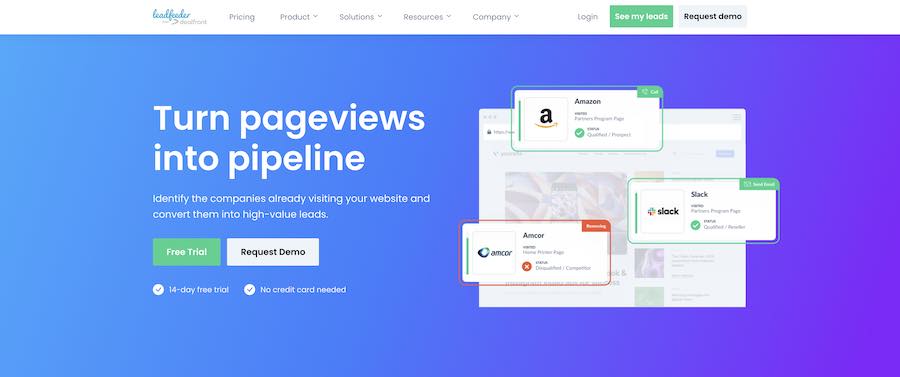
Leadfeeder is an online business platform that helps you identify potential customers, acquire leads, and target customers to close sales.
It offers four significant solutions: lead generation, account-based marketing, website visitor tracking, and sales prospecting.
The lead generation tool provides information like who visited you, how they got there, what pages they clicked, and their goals. Leadfeeder acquires all this information using rich customer data and by tracking customer behavior.
Here’s how Leadfeeder generates and uncovers your hidden leads:
- Identify Visitors – They show you the name of the companies visiting your site.
- Qualify Leads – Leadfeeder prioritizes and segments your leads based on their actions.
- Connect – Connect to decision-makers based on company and contact information.
- Send Leads – Further, send leads to your company and update your CRM.
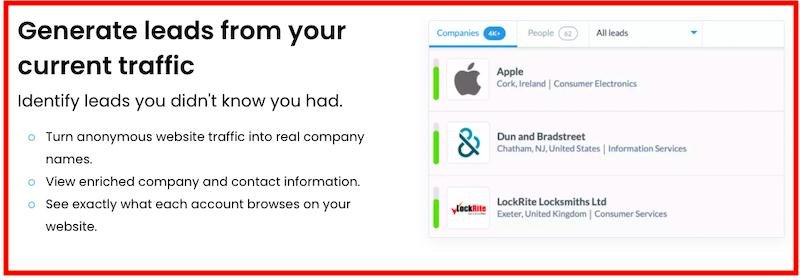
Leadfeeder carries out the entire lead generation and acquisition process automatically. It also builds customized sales pitches using customer data and tallying the sales with the marketing data.
Some of its key features include:
- Remove unwanted companies from the list.
- It keeps a track record of data and leads quality.
- Enhance the follow-up process using customer insights.
- Channel data from Leadfeeder to your CRM and vice versa.
- Get notified if there’s any action from your target company.
- Segment and create feeds based on employee number, web activity, etc.
- Filter out the priority leads, scrubbed of bots, ISP’s, and other redundant leads.
It also integrates with other business tools you may already use to streamline your marketing strategy. Popular integrations include Pipedrive, Mailchimp, Salesforce, Zoho, HubSpot, Zapier, Microsoft Dynamics, Slack, ActiveCampaign, Google Hangouts Chat, etc.
Your CRM system gets updated automatically if you integrate it with Leadfeeder. It also sends qualified leads to your connected CRM (Customer Relationship Management) or marketing automation system.
Pricing
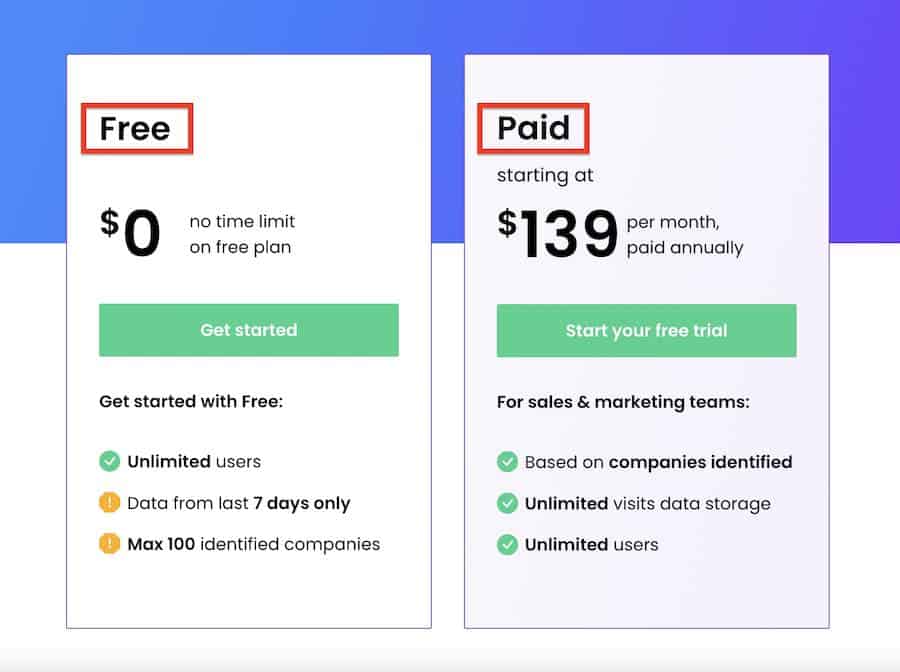
Leadfeeder comes with two plans, including:
- Lite: Always free
- Premium: from $139 per month
The Lite plan is a basic version of Leadfeeder and offers limited features showing only the last three days’ worth of leads. On the other hand, The Premium version provides unlimited data retention and leads.
The Premium plan also provides advanced features like contacts database, company details, integrations, powerful filtering, etc. You also get a 14-day free trial.
6. Mailchimp.
Best for small and mid-sized businesses ($9.99 per month).
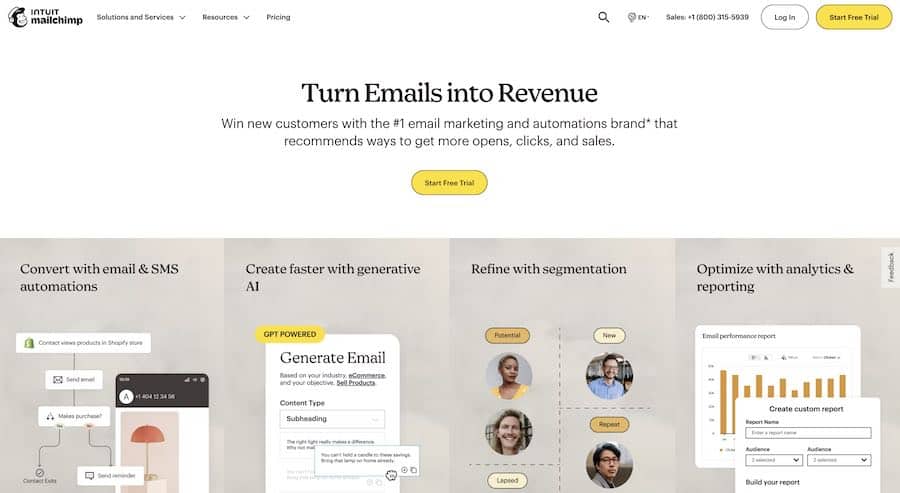
Mailchimp is an email marketing service that helps you generate leads, gain email subscribers, send emails, and even create websites.
It displays customer data, marketing channels, and insights in a single dashboard to streamline your marketing.
It’s suitable for small businesses and helps create landing pages and connect data to a customer relationship management (CRM) system. Mailchimp enables lead generation through two main solutions i.e.: getting your business online and marketing your business.
To market your business, it helps you build marketing campaigns and analyze both past and future campaigns. You can also track your customers’ journeys and deliver messages across all channels.
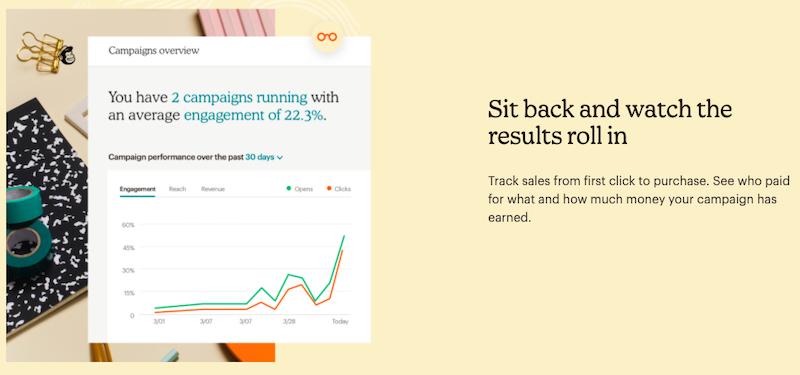
Overall, Mailchimp offers four services to market your business and generate leads:
1. Audience Management.
Audience tools leverage customer data to create insights and personalize content. They pull all of the customer data from apps like Salesforce, Pipedrive, and multiple CRM software tools connected with the dashboard.
Other features include creating sign-up forms, audience dashboard, segmentation, predicted demographics, behavioral targeting, and more.
2. Creative Tools.
This provides tools to promote your brand’s individuality. There’s a “Content Studio” that helps you sync, store, and edit your files in a single dashboard. You can also leverage an AI-based creative assistant to create personalized, on-brand designs.
Other services include personalized content blocks to create dynamic content, 100+ pre-designed landing pages, email templates, and custom domains. All of these features enable you to create a brand identity.
3. Marketing Automation Tools.
Marketing automation software helps you engage your customers using trigger-based emails and tracking customer journeys. Key features include date-based automation (including transactional email), scheduling through marketing calendar, pre-built workflows, and more.
4. Insights and Analytics.
Mailchimp provides tools to analyze customer engagement and measure metrics like ROI. You can extract essential insights using real-time reports, A/B testing, surveys, and smart recommendations.
Other features include pre-designed and customizable color palettes, themes, layouts, real-time content editing, built-in SEO tools, domain customization, etc.
Additionally, Mailchimp allows integration with over 250 business apps like Calendly, Stripe, WooCommerce, Hootsuite, Google Analytics, Canva, etc.
Pricing
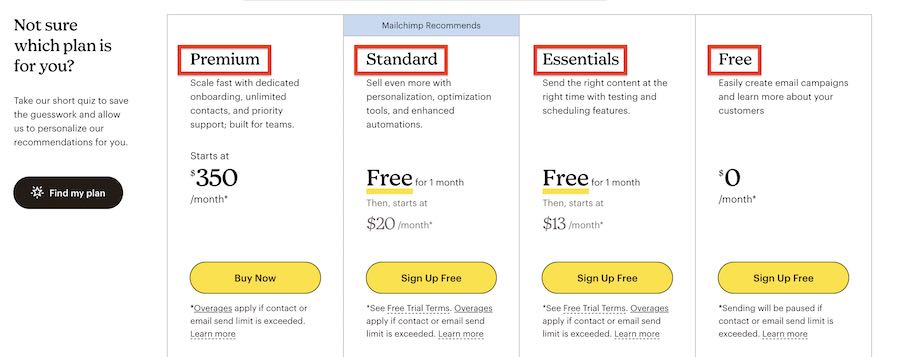
Mailchimp offers four pricing plans:
- Free: $0 per month
- Essentials: $13 per month (Free your first month)
- Standard: $20 per month (Free your first month)
- Premium: $350 per month
All of the plans provide features like a creative assistant, marketing CRM, website builder, Mailchimp domain, and more.
7.Overloop.
Best for building your email list and subscribers.
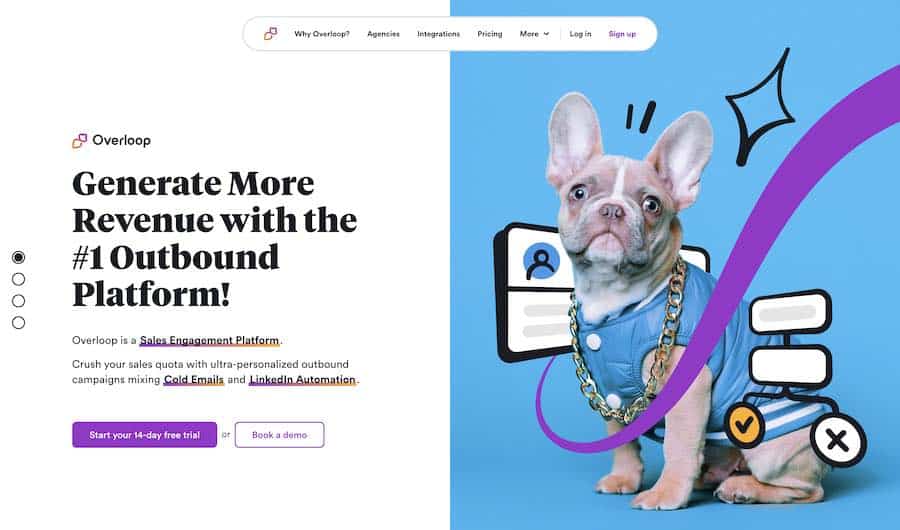
Overloop is a sales automation platform that helps you find prospects, capture leads, manage lead information, and launch email campaigns. It lets you build lists, get a list of everyday tasks, automate multi-channel outbound activities, and analyze campaign performance.
It streamlines all your outbound emails, follow-up calls, social media posts, and tasks to create a multichannel campaign. This helps you reach your prospects wherever they are and capture leads.
Overloop also provides reports and helps you track your sales objectives to make sure you’re meeting your sales quota. It also allows 2-way sync integrations with tools like HubSpot, Pipedrive, Zoho, Salesforce, Slack, and more.
The tool’s ability to automate all sales and lead generation tasks is a bonus. It can add leads both manually and automatically based on predefined filters and criteria. You can also build conditions and workflows to redirect prospects to take relevant paths and actions.
It also allows you to review Interactions with prospects to send personalized emails. You can also access action blocks like task creation, field updates, instant notifications, and more.
Other most prominent features include:
- Run A/B tests.
- It generates a list of tasks daily within campaigns.
- Built-in list segmentation tool.
- It has a Chrome Extension.
- Create email sequences and multi-touch drip campaigns.
- Create and manage email templates.
- Track open-rate, click-rate, bounce-rate, and more.
- Share real-time statistics and keep track of your sales in real-time.
Overloop also enables mailbox automation and lets you send cold emails by connecting with your email address. It supports Google (Gmail or GSuite), Microsoft Office 365, Microsoft Exchange, and SMTP/IMAP server.
Additionally, it has a built-in “email finder” that uses algorithms to send bulk emails by simply entering the lead’s name. It also verifies the email addresses of your leads to avoid bouncing. You can even use it to collect all emails linked to the domain of your lead’s website.
You can also browse the store by Overloop that offers a range of advanced add-ons, plugins, and widgets. It offers add-ons like CRM ( HubSpot, Pipedrive, Salesforce, and Zoho), REST API, LeadsBridge, PieSync, and Zapier. You can even integrate your own tools.
Pricing
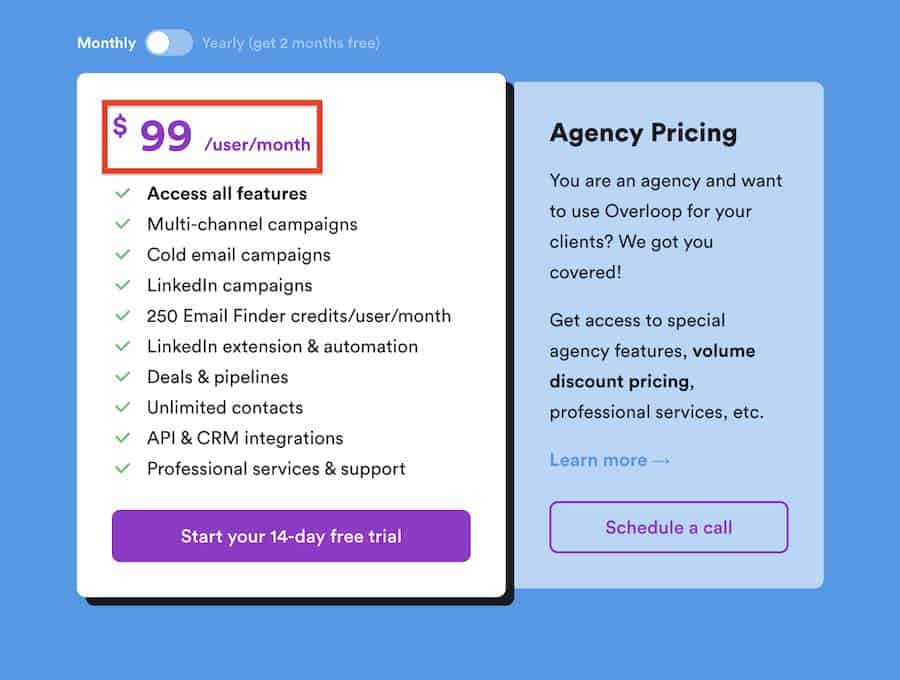
Overloop offers one subscription that costs $99 per user per month.
After that, users include add-ons on top of the base subscription depending on their specific needs. Three professional add-ons are currently available:
- Agency Pricing: from $99 per month
You can also add multiple add-ons by having a chat with their support.
What is Lead Generation Software?
A lead is any person who shows interest in either your service, company, or product. Lead generation software helps you automatically generate leads from multiple channels and direct the leads towards your marketing or sales team for conversion.
Leads typically get generated when a customer visits your website and communicates via the personal data provided.
A good lead generation platform helps you with lead scoring, conversion rate optimization, lead nurturing, customer engagement, and more.
Here are the top benefits of using a lead generation tool:
- It helps you analyze and monitor your website’s traffic.
- Automate marketing efforts and sales activities.
- Track user engagement and interactions.
- Personalize and optimize opt-in forms.
- Enhance social media strategy.
- Gather data and actionable insights to identify potential customers.
Every type of industry and company can benefit from incorporating lead generation strategies, including individual marketers, startups, and large corporations.
What Features Do You Need in Lead Generation Tools?
Different lead generating platforms may come with various key features and specialties. However, the best lead generating software comes with some standard features.
Consider all these features before choosing a lead generation tool:
1. Ease-of-use.
An ideal tool should be easy to use for even beginners and new businesses, not just experienced tech experts. The software should not be entirely code-centric. It should be easy enough to give every employee in the company the comfort of working with it.
2. Third-Party Integrations.
Another key aspect of a good lead generating software is its capability to integrate with other business apps seamlessly.
Integration is essential to streamline marketing, online sales, and lead generation data and get things done using a single source. Sales teams use these integrations to get information that helps them close the sale and boost their lead generation efforts.
3. Reporting and Analytics.
This holds for every automated tool, including a lead generating software. Every lead generating software must be able to analyze and optimize all data gathered.
Besides streamlining customers from multiple channels, you will also get an insight into your company’s performance and plan future actions.
4. CRM System.
Your lead generating software should come with a built-in CRM system to track all customer data. For example, a lead generating tool like HubSpot gives you all of the tools required to provide your customers with a personalized experience.
From scheduling meetings and emails to sales automation, a good lead generating software should help both sales and marketing teams to be able to do it all.
5. Scalability.
The ultimate goal of a business is to maximize its customer outreach, revenue, and ROI. Your lead gen tool should be flexible enough to adapt to the present situation, i.e., with the growing industry.
6. Exit Intent Technology.
Your tool should be able to detect the mouse movements of your customers and offer lead gen upon exit intent.
Exit-intent technology is based on behavioral technology that monitors the movement of your mouse on the website. It works in a way that whenever a customer is about to exit the site without purchasing, the site automatically displays exciting offers.
Here are some other points to consider before choosing a lead generating platform:
- It must provide AI bot facilities to promote customer self-service.
- Some lead generating applications come with pre-designed themes and templates.
- It should be easily accessible by your entire team and from anywhere.
- It should offer the “Geo-tagging” functionality. Every software should be able to capture information from different sites and optimize and sort it in the form of field maps.
How Do You Use Lead Generation Software?
Many lead generation platforms offer similar functions and work similarly.
Here are some elements that can help you in the process of generating leads:
- Call-to-action – Lead generation begins when customers land on your page and click on the CTA box. CTA boxes generally include interactive buttons like “Register Now,’ “Free for one month,” “Click Here,” and more.
- Landing page – Clicking on the CTA will take customers to the landing page, where they fill a digital form with essential details.
- Thank You page – After the form’s fulfillment, customers are directed towards the “Thank You” page.
A lead gen tool helps you capture leads and direct customers through the entire sales flow.
Here, I’m using OptinMonster to demonstrate the process of using a lead generation service.
1. Create a Campaign.
You’ll come across the “Create Campaign” button after logging in to your OptinMonster account.

Next, choose a campaign type. You will get options like Popup, Fullscreen, Slide-in, Floating Bar, and Inline.
You can customize their pre-built template or design a campaign from scratch. Fill in all of the details to make your offer stand out.
You can further add/edit various elements, including:
- Add or remove rows and columns.
- Personalize border color, border style, background color, and more.
- Add your selected image and content.
- Set a timer for the discount or the offer to start.
- Create a CTA tab to collect subscriber information.
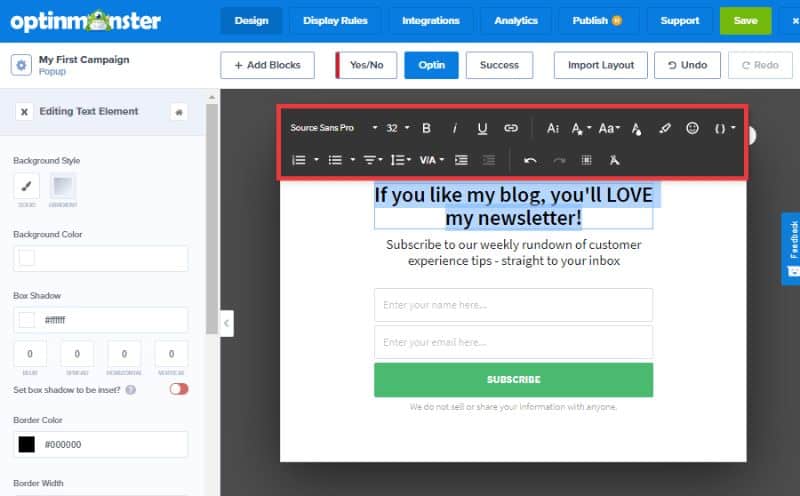
2. Set Your Target Audience and Display Rules.
After creating your campaign, set the “Display Rules” from the topmost bar of your OptinMonster builder.
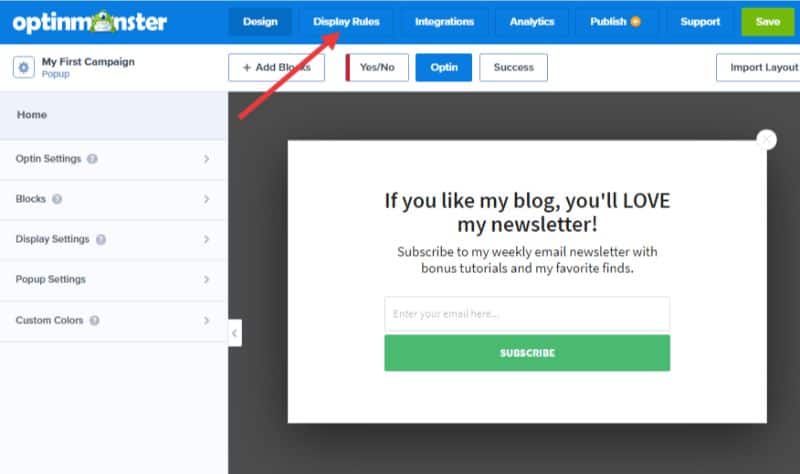
With the help of “Behavioral Technology,” show the right offer to the right customers and at the right time.
Follow these points before setting your display rules:
- Create a personalized message to interact with your customer.
- Optimize and monitor the engagement of each client.
- Set a trigger for as soon they are about to leave.
- Engage customers with more offers.
Finally, publish the campaign by clicking on the “Publish” button from the dashboard.
3. Analyze Your Campaign.
You can connect your campaigns with Google Analytics to automatically track and measure metrics like impressions, conversions, and highest converting pages.
Make sure to get access to real-time data to alter or enhance your lead generating strategies.
Keep these things in mind while analyzing your results:
- Get access to campaign-specific analytics.
- Get hold of real-time results.
- Run A/B or split tests.
- Get promotional opportunities.
Other Important Lead Generation Aspects To Consider
Lead management software can be the missing link between the relevant departments in an organization. Generating quality leads is the lifeblood of a business and the right lead generation software can help achieve this.
While there are various lead generation solutions in the market, choosing the right one for your specific organization is key.
One thing to consider is that once you have your process dialed in, it’s also possible to offer lead generation services to others – these services are always in demand by both agencies and individuals that sell products or services.
Online lead generation is more important than ever before to get high conversion rates and long-term ROI.
The lead generation process might look simple, but prospective customers will not be able to find you without the right tools.
The importance of qualified leads
Getting qualified leads cannot be overstated, as they are the ones that have the highest chance of turning into customers. The pressure to generate leads can be immense because those potential customers, who want and need your products and services, expect you to reach out and communicate with them.
Leads also need to be continuously generated through various marketing campaigns, which explains why it’s vital for marketers and business owners to find a good lead generation tool.
Lead management systems may not be the end-all solution but they can help bring order (and sanity) by helping you collect data from separate sources like social media platforms, e-commerce sites, and more – all in one place, where you can access them without difficulty.
Best Ways To Convert Leads Into Paying Customers
Having the top lead generation in place in your company is of course not enough if you do not have a way to convert the leads into actual paying clients. With more data available at your fingertips, you can focus on providing personalized experiences for each lead to convert them into being long-term loyal customers.
Lead management software is also essential for understanding what makes prospects tick because by collecting information from various sources, it’s possible to construct the perfect buyer persona that will help better inform your marketing strategies.
The following steps will help you get started.
1. Analyze your current lead generation process
Look at what you already do and look for ways to optimize it by evaluating:
• Leads sources: Where are you getting leads? What campaigns and platforms tend to work the best and generate more qualified prospects? Evaluate where you can reduce or increase spending on advertising, especially in targeted markets or niches.
2. Look for a solution that will help automate the lead management process
Lead generation software like Infiniium can help bring all of your data together so sales, marketing, and customer service departments can access information with ease. It would also be helpful if the system enables easy collaboration between team members, allowing them to add notes and insights about each prospect in one place.
3. Focus on personalized, relevant, and timely messaging
No matter how many leads you generate, if your company ends up spamming people who do not want to hear from you, then it’s a lost opportunity. Invest time and money into developing customer personas that will help better your outreach strategies and content marketing efforts – this way, you can adjust the messaging according to each persona’s specific wants and needs.
4. Have a good follow-up process
With the lead management systems mentioned in this post, it is easier than ever before to identify which customers are at risk of leaving so it would be beneficial to have an automated system that follows up with every customer before they become lost opportunities. Always focus on making your pitches relevant to your prospects because they can help you acquire more customers that will be loyal for the long haul.
5. Make closing a prospect feel easy
Streamline your sales process and always follow up promptly because those who are ready to purchase want to proceed as soon as possible. They may already have made up their mind about doing business with you, so take an interest in working with their needs and expectations to close the sale as quickly as possible.
Summary.
That was my guide to the best lead generation software on the market.
Whether you need to generate leads, gain email subscribers, or create automated campaigns, these platforms can help:
- HubSpot: Best overall lead gen tool.
- Intercom: Best for connecting with chatbots to engage website visitors.
- Leadfeeder: Best for streamlining lead gen with your CRM system.
- OptinMonster: Best for exit-intent pop-ups.
- Mailchimp: Best for small businesses.
- Unbounce: Best for creating personalized landing pages.
- Overloop: Best for building your email list and subscribers.
For more marketing tactics, check out some of my other related articles:
Which one of these tools are you planning to use, and why? Let me know by commenting below.



